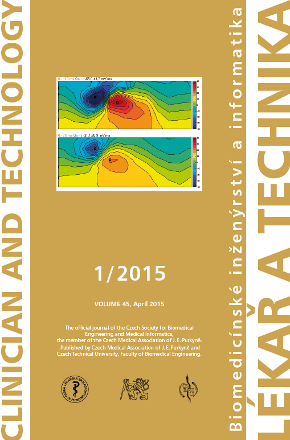EXPERIMENTAL MODAL ANALYSIS OF ULTRASONIC SURGICAL WAVEGUIDES USING EFFECT OF INVERSE MAGNETOSTRICTION
Keywords:
modal analysis, ultrasonic waveguide, inductive sensor, inverse magnetostrictionAbstract
Experimental modal analysis (EMA) of ultrasonic waveguides is important for many applications including design of ultrasonic surgical tools. However, most of the known sensors and instruments for measuring parameters of ultrasonic vibrations are limited to the measurements on the face surface of the ultrasonic waveguide and therefore unable to determine the spatial distribution of the parameters along its length, which in turn makes it difficult to identify natural modes and shapes. The article describes EMA of ultrasonic surgical waveguides based on the effect of inverse magnetostriction. During vibration of an ultrasonic waveguide the inverse magnetostriction generates alternating magnetic field which can be detected by means of an induction coil. Spatial resolution of the measurements can be achieved by application of the sensors with flat (spiral) induction coils. The sensors used in the study have simple design and low cost making them affordable for wide circle of scientists and engineers. The results of experimental studies implemented on exemplary waveguide for ultrasonic angioplasty made of AISI 321 steel are presented and discussed. The article also discusses the methods for theoretical and experimental determination of the sensitivity of the sensors used in the study. Experimental data are validated by comparing them to the results of computer-aided modal analysis using the finite element method (FEM) and found to be in good agreement with the results of FEM modeling (relative deviation of the vibratory displacements amplitude is about 4.7 %). As it follows from the experimental data and their comparison to the results of FEM modeling, the effect of inverse magnetostriction can be efficiently used for EMA of ultrasonic waveguides.
Downloads
Published
Issue
Section
License
Copyright (c) 2017 D. Stepanenko, V. Minchenya, K. Bogdanchuk

This work is licensed under a Creative Commons Attribution 4.0 International License.
Authors who publish with this journal agree to the following terms:
- Authors retain copyright and grant the journal right of the first publication with the work simultaneously licensed under a Creative Commons Attribution License (https://creativecommons.org/licenses/by/4.0/) that allows others to share the work with an acknowledgment of the work's authorship and initial publication in CTJ.
- Authors are able to enter into separate, additional contractual arrangements for the non-exclusive distribution of the journal’s published version of the work (e.g., post it to an institutional repository or publish it in a book), with an acknowledgment of its initial publication in this journal.
- Authors are permitted and encouraged to post their work online (e.g., in institutional repositories or on their website or ResearchGate) prior to and during the submission process, as it can lead to productive exchanges.
CTJ requires that all of the content of the manuscript has been created by its respective authors or that permission to use a copyrighted material has been obtained by the authors before submitting the manuscript to CTJ. CTJ requires that authors have not used any copyrighted material illegally, as for example a picture from another journal or book, a photo, etc. It is the author’s responsibility to use only materials not violating the copyright law. When in doubt, CTJ may ask the authors to supply the pertinent permission or agreement about the use of a copyrighted material.
The opinions expressed in CTJ articles are those of authors and do not necessarily reflect the views of the publishers or the Czech Society for Biomedical Engineering and Medical Informatics.


